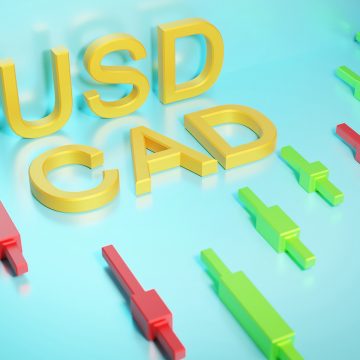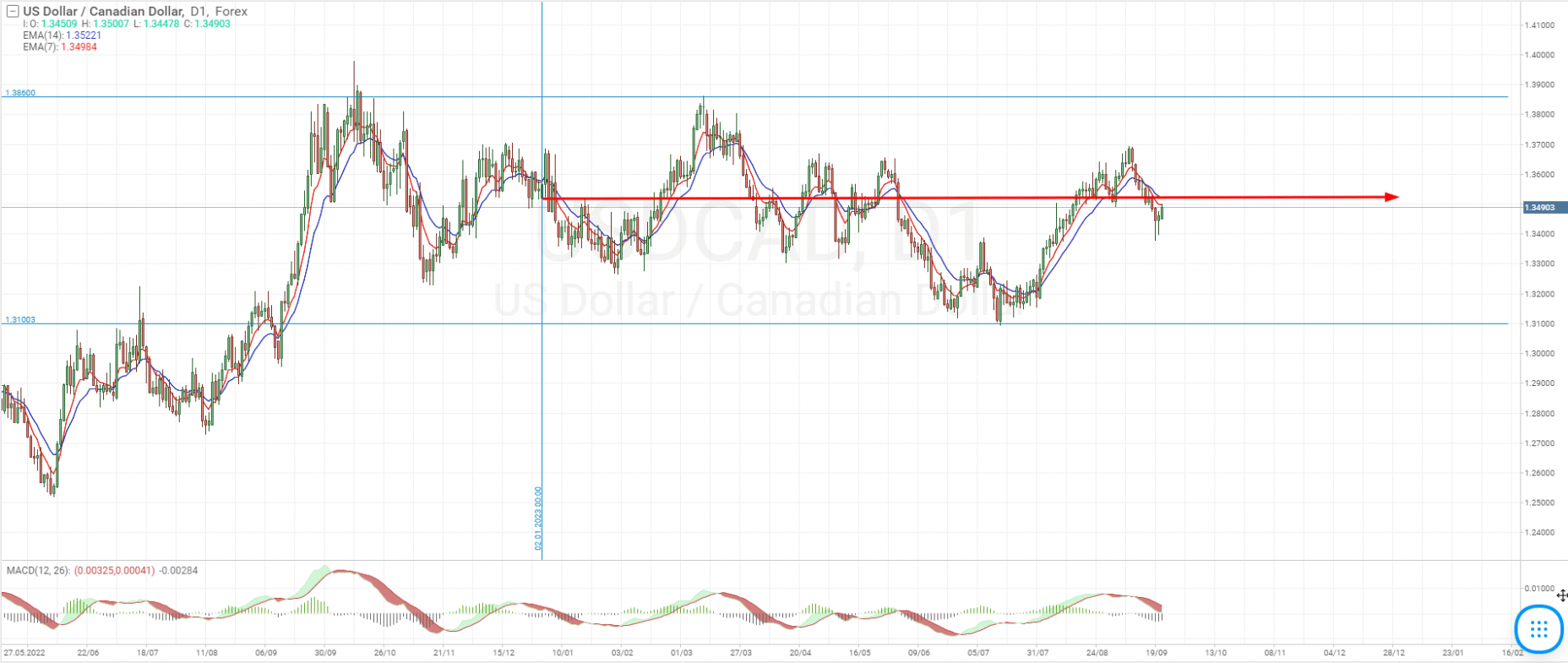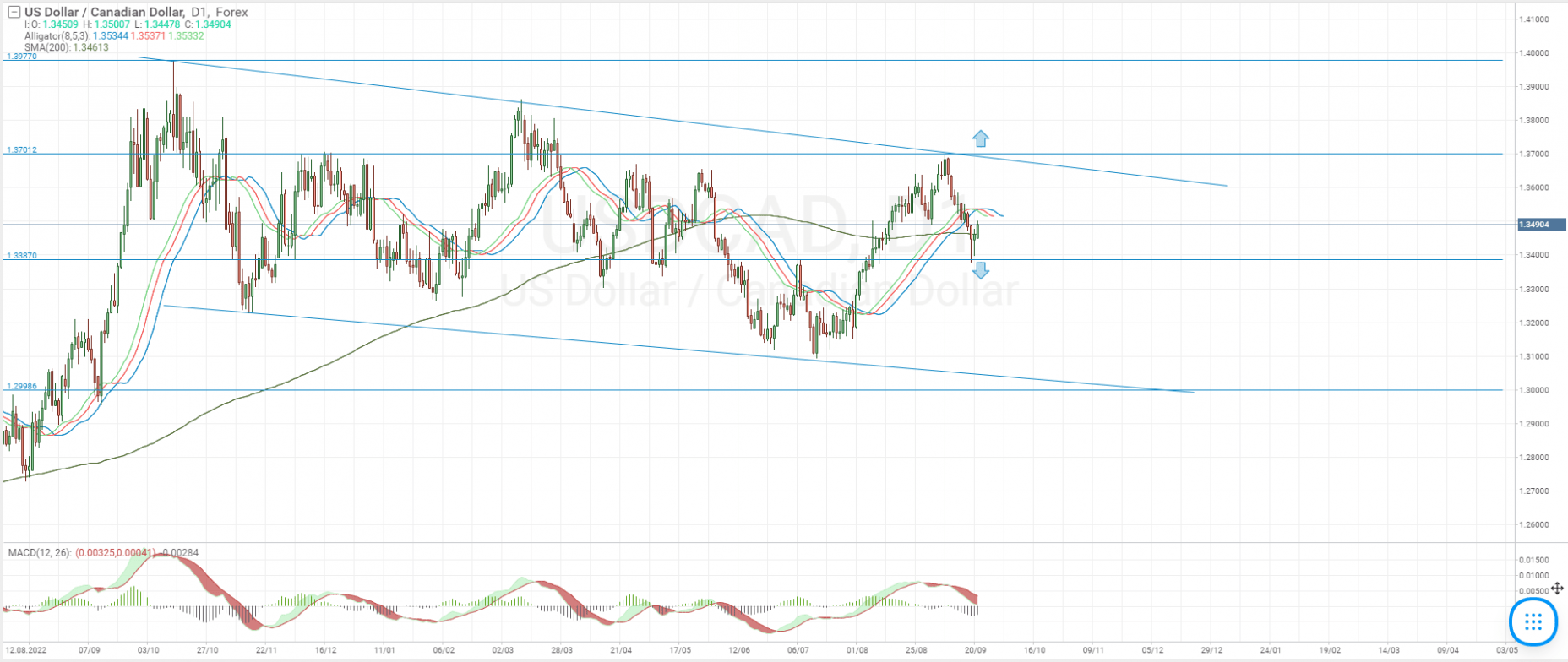
The USD/CAD is one of the most demanded currency pairs in international trading. In this article, we will examine the key factors affecting the pair’s exchange rate, analyse the dynamics of price changes in 2023, and explore the short-term and medium-term forecasts provided by experts.
Overview of the USD/CAD currency pair
USD/CAD shows the ratio of the US dollar (USD) to the Canadian dollar (CAD). Its quotes indicate how many Canadian dollars need to be paid for one US dollar. When the pair exchange rate rises, this means that the US dollar is strengthening against Canada’s currency. When the exchange rate drops, this signals that the Canadian dollar is on the rise against the US dollar.
Trading characteristics of the USD/CAD pair
- The currency pair is traded round the clock from Monday to Friday, with significant trading volumes and maximum volatility during the American trading session. During this period, the US and Canada release the most crucial economic statistics that have a great impact on the pair exchange rate
- USD/CAD can be considered quite a volatile pair, characterised by average daily movements ranging from 800 to 1,000 pips. During periods of strong global market movements, its volatility may increase to 2,000-3,000 pips per day in the short term
- USD/CAD is one of the major currency pairs, which is why the spread is small thanks to its popularity and high liquidity. In a normal market environment, the spread ranges from 10 to 15 pips in popular ECN accounts
Fundamental factors influencing the USD/CAD quotes
The Bank of Canada’s monetary policy
The Bank of Canada has been tightening its monetary policy since March 2022 to bring down inflation. Over this period, the interest rate has been raised nine times and is standing at 5% at the time of writing on 21 September 2023.
When making decisions on interest rate hikes, the country’s central bank assesses how much trends in excessive demand, inflation expectations, wage growth, and corporate pricing are in line with achieving the inflation target of 2%.
Inflationary pressure has been easing in the country since June 2023. Therefore, the Bank of Canada took a pause in a series of interest rate hikes to assess how steady a fall in inflation will be. It is keeping a close eye on economic indicators, and if inflation continues to rise, it may raise the interest rate, thereby supporting the Canadian dollar.
The US Federal Reserve’s monetary policy
The US Federal Reserve is also seeking to bring down mounting inflation by tightening monetary policies. Since 2022, the interest rate has gradually risen from 0.25% to 5.5%. This significantly affected the quotes of the US dollar, which had strengthened markedly against many world currencies over this period.
On 20 September 2023, the Fed left the interest rate unchanged at 5.5%. The regulator noted that economic activity continues to grow steadily, and although job gains have slowed, they remain impressive. The Fed’s chair confirmed that inflation remains high with inflation risks being the focus of attention. Analysts predict that the US will see one more interest rate hike by the end of 2023.
The tightening of the monetary policy exerts considerable pressure on the US economy. High inflation and slowing economic growth, along with concerns about the stability of the banking sector, add to conditions for a potential recession. In this scenario, the USD might decline against the CAD and other world currencies.
Oil prices
The performance of the Canadian dollar also depends on commodity prices, primarily on oil prices. Canada is a large exporter of natural resources, mostly, of oil while the US is the primary target market. Due to the strong impact of oil prices on the exchange rate, the Canadian dollar is regarded as a commodity currency.
Such currencies are characterised by a decline in the price when the investment environment worsens and demand for natural resources falls. On the contrary, an increase in oil prices provides support for the Canadian currency. Rising crude oil prices drive a decline in the USD/CAD exchange rate since the Canadian currency is strengthening. A drop in oil prices, on the contrary, pushes up the currency pair as Canada’s currency is weakening.
Following a drop at the beginning of the year, oil quotes have been demonstrating steady growth of more than 30% since June 2023, up from 72 to 95 USD per Brent barrel. This movement is attributed to the OPEC+ policy aimed at limiting oil production. Should oil prices go up further, this could provide considerable support for the Canadian dollar exchange rate and trigger a decline in the USD/CAD quotes.
Economic development indicators of the US and Canada
- Unemployment Rate
- Nonfarm Payrolls
- GDP Growth Rates (GDP)
- Inflation Indices (CPI, PPI)
- Industrial Production (Industrial Production Index)
- Retail Sales
- Trade Balance
- Consumer Confidence Index
- ISM Manufacturing Purchasing Managers Index
USD/CAD performance in 2023
The Canadian dollar shows mixed trends, trading within a wide sideways range. In March 2023, the upper limit of this range was set at the 1.3860 mark while the lower limit formed at 1.3100 in July. At the time of writing, the USD/CAD quotes are demonstrating a moderate downward movement on the daily chart, hovering approximately in the middle of the price range at 1.3500.

USD/CAD live chart
USD/CAD technical analysis
After hitting an annual high of 1.3977 in October 2022, the currency pair has been trading within a wide descending price channel on a daily chart. In early September 2023, the price rebounded from the upper limit of the channel at 1.3700, forming a downward reversal. The quotes experienced a strong descending momentum, reaching a significant support level at 1.3387 located near the 200-day Moving Average.
At the time of writing, there is an upward correction, which may be followed by a downward momentum. A key resistance level is the 1.3700 mark. If this level breaks upwards, this could open the way for an upward movement to 1.3977 and higher. In case the quotes gain a foothold below the support level at 1.3387, this may confirm a descending scenario with the quotes potentially declining further to the lower line of the price channel at 1.3000.

USD/CAD forecast for 2023
- Analysts at J.P. Morgan Research predict that the USD/CAD quotes will hover around 1.3500 by the end of 2023
- Citibank specialists suggest that the pair reaches 1.3400 by the end of 2023 and the beginning of 2024
- ING Group economists believe that the Canadian dollar will be on the rise with the currency pair dropping to 1.2700 by the end of the year
Long-term USD/CAD forecast
- HSBC experts presume that the US dollar is currently overvalued and will revert to fair value within five years as US yields decline and equity markets gain. They expect the USD/CAD exchange rate to stand at 1.2700 by mid-2024 and fall further to 1.2500 by 2026
- Analysts at the Economy Forecast Agency (EFA) forecast that the rate will be 1.3580 by the end of 2024, 1.4050 by the end of 2025, and 1.2840 by the end of 2026
- According to the Wallet Investor portal, USD/CAD will reach 1.3780 by the end of 2024 and 1.3870 by the end of 2025
Summary
The USD/CAD currency pair demonstrates a sideways movement in 2023, standing at virtually the same level at the time of writing as at the beginning of the year. The US and Canadian regulators are tightening monetary policies to ease the mounting inflationary pressure. Interest rates currently stand at 5.0% and 5.5% respectively, with none of the currencies gaining distinct advantages.
The key factors for further movement of the USD/CAD are the pace of economic growth in these countries, along with the policies of central banks, and trends in oil prices. Oil quotes have been showing solid growth since June 2023 thanks to the OPEC+ decision to cut production. If this upward momentum persists, it could provide additional support for the Canadian dollar and trigger a potential decline in the currency pair exchange rate. Should oil prices go down, the pair could gain additional momentum for growth.
FAQ
1. Why is USD/CAD forecasting important?
Forecasting is important for strategic planning and risk management, helping investors predict possible movements of the currency pair.
2. What methods are used to forecast USD/CAD?
Commonly employed methods include fundamental analysis, technical analysis, and sentiment analysis.
3. How accurate are USD/CAD forecasts?
While forecasting methods have their advantages, they are not entirely reliable. A wide range of factors can affect USD/CAD and trigger unexpected price movements.
4. What are the risks in USD/CAD forecasting?
The primary risk lies in the unpredictability of global political and economic events that can significantly affect the USD/CAD rate.
5. What potential future events could trigger changes in the USD/CAD exchange rate?
The list of potential events is extensive, including shifts in the monetary policies of US and Canadian regulators, considerable fluctuations in oil prices, geopolitical changes, natural and human-caused disasters, as well as crisis developments in national and global economies.
6. Will the USD/CAD exchange rate continue to remain volatile?
Influenced by various factors, the USD/CAD rate may maintain its volatility.
7. How does the difference in interest rates affect the USD/CAD rate?
An increasing interest rate in the US contributes to the pair’s upward movement, whereas an interest rate hike in Canada exerts downward pressure on the USD/CAD quotes.
The post USD/CAD Forecast: Will the Canadian Dollar Rise in 2023? appeared first at R Blog – RoboForex.






